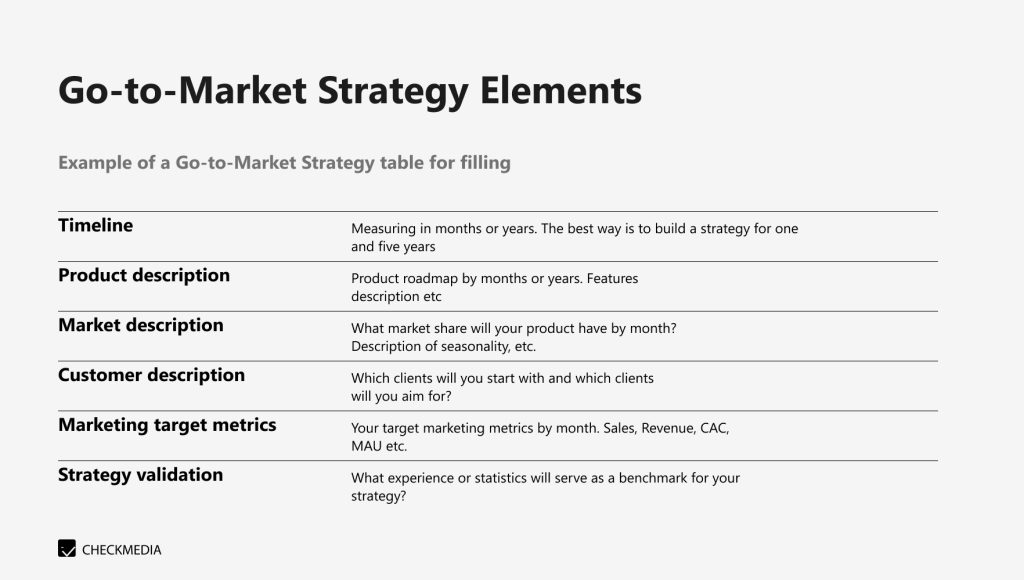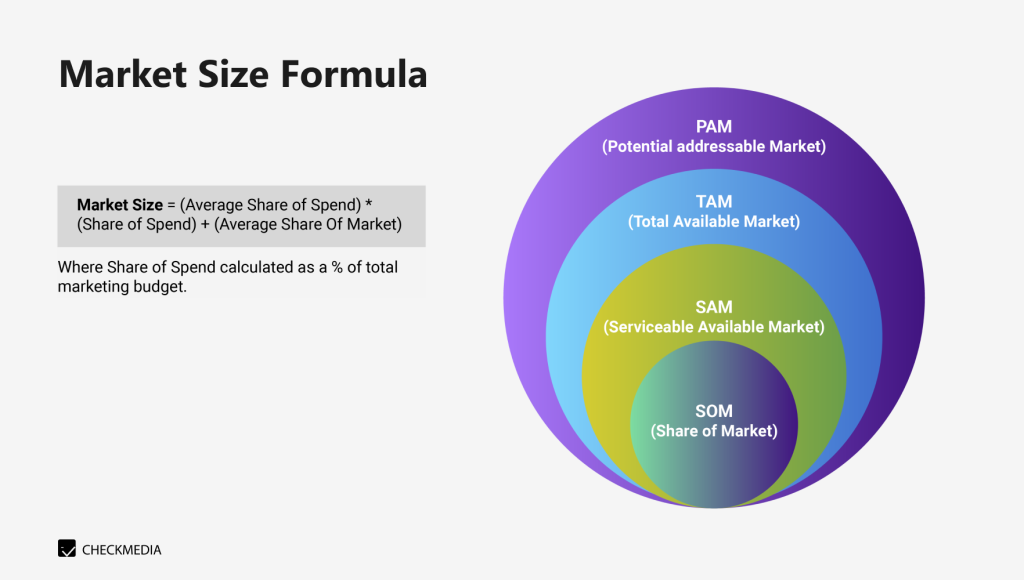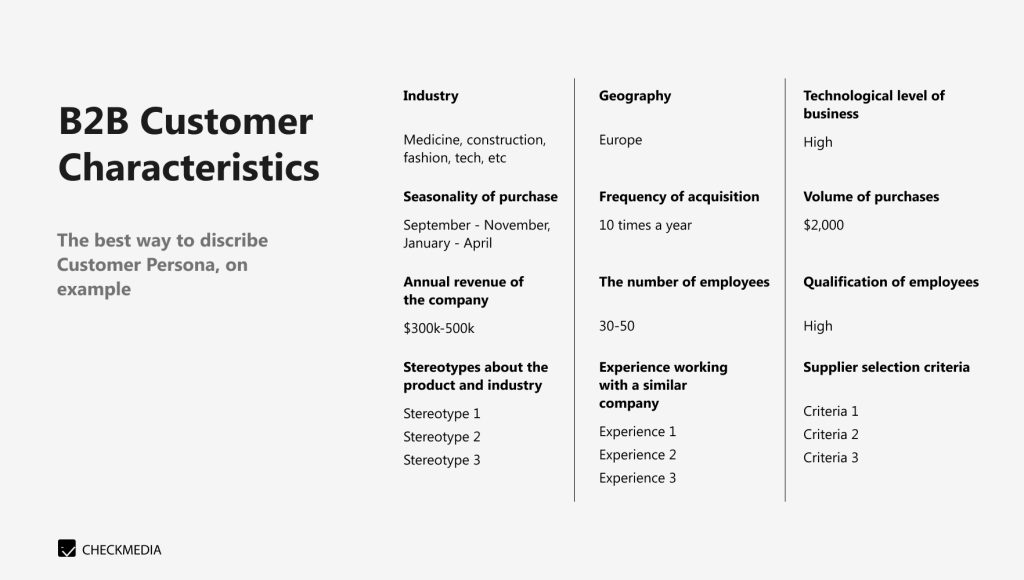
Comprehensive Guide on Go-to-Market Strategy with Examples
Typical issues on Go-to-Market Strategy
There are two kinds of people who need a Go-to-Market Strategy. These are company executives and marketing managers, CEO and CMO.
A typical problem for a CEO is when the CEO has a goal for annual profit, but has no strategy on how to achieve it.
A CMO often faces the challenge of first creating a strategy and then creating tactics. It often happens that CMO first creates tactical solutions, and only then strategic ones.
What is a Go-to-Market Strategy
Simply put: Go-to-Market Strategy is a company’s plan for market expansion.
Tip: If a company has several products, then it is better to prepare a Go-to-Market Strategy for each product.
A Go-to-Market (GTM) strategy is a comprehensive plan that outlines how a company will introduce and promote its products or services to the market. This strategy is a roadmap that encompasses various key elements, starting with a clear identification of the target market, sales and marketing efforts.
The GTM strategy also delves into defining the unique value proposition and brand positioning to differentiate the offering in a competitive landscape. Additionally, it involves identifying and prioritizing target markets, specifying the channels and tactics for marketing and sales, and detailing the timing of each phase of the plan. Ultimately, a well-crafted GTM strategy ensures a cohesive and effective approach to bring a product or service to market, optimizing the chances of success in a competitive business environment.
Your go-to-market strategy is simply a roadmap for how you’ll take your product to the market. It is essential for laying the groundwork for a successful business moving forward.
What does a Go-to-Market strategy look like
A properly builded GTM Strategy looks like a document or table which will become the basis for further marketing activities and investment decisions. This is a key document that sets marketing target metrics and key descriptions. A good GTM Strategy involves optimistic, realistic and pessimistic scenarios on how to achieve target metrics.
Tip: Build GTM Strategy as a table if you are going to follow it yourself. Or create GTM Strategy as a presentation if you were asked once by management for a demonstration at a meeting.
What is included in Go-to-Market Strategy
Simply put: In this section, you will learn the key elements of GTM strategy.
A good strategy includes a description of key marketing objects and target marketing metrics. Check the list of GTM Strategy objects and answer the questions to find out how to build a good GTM Strategy.

Product description
Answer the questions:
- What do we want to sell? What type does our product belong to: SaaS, Ecommerce, FinTech, Consumer Goods, B2B etc?
- What customer needs does our product satisfy?
Market description
The market description includes a description of Total Addressable Market, Serviceable Available Market and Serviceable Obtainable Market.

Total Addressable Market (TAM) is a whole market that includes available clients and your competitors’ clients. It is measured in the number of customers or the amount of money that customers are willing to spend on your product.
The Total Addressable Market includes other available markets:
- Serviceable Available Market (SAM) is a total market of available customers that you can capture.
- Serviceable Obtainable Market (SOM) is an accessible market of customers that you can capture first with minimal effort.
Customer description
Answer the questions:
- Who will buy your product in general? As we already know, the market is measured in customers. What characteristics unite all customers in the TAM?
- What characteristics unite buyers in the SAM?
- What characteristics unite buyers in the SOM?
Timeline
Like any strategy, Go-to-Market Strategy must have a time frame. Our tip is to start with the annual dates.
Depends on your needs make a primarily GTM Strategy for 1 year and a general one for 5 years:
- Typically, marketers build GTM strategy for one year to prepare marketing tactics and activities.
- Managers and investors require a 5-year geological and technical strategy to create a long-term cost and return on investment plan.
Marketing target metrics
Any CMO must set target marketing metrics when building a GTM strategy. To build a GTM Strategy, marketers metrics are used.
There are two types of metrics:
- Outcome metrics are target metrics that directly affect the business. These are the first metrics that CEOs and investors look at. For example: CAC, ROAS, LTV, ARR, Sales etc. These metrics are used to build a valid GTM strategy.
- Output metrics are intermediate metrics that are influenced by marketing tactics. For example: CTR, CPM, CPC. These metrics are used for tracking marketing campaigns.
GTM Strategy validation
To validate your GTM Strategy, support your calculations and forecasts with practical research. Leave links to research or support the data with your own cases.
Go-to-Market Strategy examples
Let’s take a look at Go-to-Market Strategy examples for B2B, Startups and SaaS products.
B2B Go-to-Market strategy
The main characteristic that distinguishes B2B types of GTM strategies from others is that the customers will be other companies, not individuals. And marketers need to build their GTM strategy based on these specifics.
B2B product description
Identify what type of product you sell. There are three typical types of B2B products:
- Entering products (commodities or components)
- Foundation products (installations or equipment)
- Facilitating products (MRO as maintenance, repair and operations)
What customer needs can B2B product satisfy:
- Good price compared to competitors
- Good quality and durability of products
- Legal clarity
- Excellent customer service
- Discounts for regular customers
- Fast processes
- Uniqueness and exclusivity of the product
Regular deal flow cycle options:
- Less than 1 month
- Half a year
- More than a year
B2B Market description
For B2B products, the market description uses the segments TAM, SAM, SOM:
- TAM is the total number of companies as customers in the market.
- SAM is the total number of companies that can be acquired for sale.
- SOM is the total number of companies that can be acquired for sale with minimal efforts.
For B2B, it is very convenient to research the market using government statistics or trusted consulting groups.
B2B Customer description

A good list of characteristics to describe a B2B customer persona:
- Industry (production of goods, provision of services)
- Subcategory (medicine, construction, fashion, technology, etc.)
- Seasonality of purchase
- Frequency of acquisition
- Volume of purchases
- Geography and presence of branches
- Annual revenue of the company
- The number of employees
- Qualification of employees
- Supplier selection criteria
- Customer growth potential
- Level of technological development of business
- Stereotypes about the product/industry
- Experience working with a similar company
Timeline
We strongly recommend you to build GTM Strategy for B2B products in 5 years cause the decision making cycle is much longer than for individual products.
B2B target marketing metrics
There are several distinctive metrics in B2B that have emerged due to the long decision-making nature of this industry:
- Marketing Qualified Lead (MQL) is a metric that describes the amount of leads who understand a product’s value but are not yet ready to be a customer.
- Sales Qualified Lead (SQL) is a metric that describes the amount of leads who are ready to be a customer but not yet buy a product.
- Lead to Close Conversion Rate (LCCR) is a metric that characterizes the ability to warm up leads before concluding a deal.
- Average Sales Cycle (ASC) is a metric that shows how long it takes to make a deal with a new lead from the first connection.
- Customer Acquisition Cost (CAC) is a metric that shows how much money you need to attract a new customer due to marketing efforts.
- Monthly Recurring Revenue (MRR) is a metric that shows how much profit comes from all your current customers per month.
- Return on Investments (ROI) is a metric that shows you how much percentage of investments on marketing efforts you return per average deal.
GTM Strategy validation
To validate B2B GTM Strategy, marketers should support their calculations and forecasts with practical cases. This data is typically provided with third party consulting agencies.
Startup Go-to-Market Strategy

There are several types of startups depends on their Go-to-Market Strategy:
- Scalable Startup makes products that are easy to scale. Typically, these are tech companies like Google with low customer acquisition costs. Typically, these startups have very high ROI.
- Buyable Startups are made to solve a narrow client problem. These startups fit perfectly into the ecosystem of large companies. If you give them access to a customer base, they can generate a lot of sales with minimal investment in marketing.
- Socially oriented startups typically have strong product sales due to the long-term impact of improving lives and high expectations that are reflected in their market value. This is everything related to the ecology and medicine agenda.
- Small business startups that have no sustainable growth plan and are happy to be small as long as the founders agree to this.
- Lifestyle Startups start as a hobby and attract new like-minded people. These startups are also willing to stay small as long as the founders agree to it.
Startup product description
Startup products vary by business model: B2B, B2C, P2P:
- B2B products are divided into SaaS, Marketplaces, Services.
- B2C products are usually divided into Aggregators, Marketplaces and Subscriptions.
- P2P products are divided into Landing, Crowdsourcing and Exchanges.
Startups market description
Various historical data are used to describe the startup market. This data can be taken from companies that collect statistics and conduct research, as well as marketing agencies that have experience in a suitable market.
Startups customer description
It is very important for a startup to describe its audience correctly. As a rule, a startup releases an innovative product that has never been on the current market. It could be a completely new idea or something old with new features or value.
Therefore, it is very important to conduct surveys of your audience to find out if they agree with the value of the product and whether new features are really necessary.
Startups marketing metrics
It is important for a startup to show the product value and its support by users. A promising startup must have an innovative product that will quickly gain revenue or a user base.
Therefore, the most important target metrics for a startup will be:
- Daily Active Users (DAU) or Monthly Active Users (MAU)
- ARR
- CAC
- Lifetime Value (LTV)
- Month-on-Month Average Growth Rate (MoM Growth Rate)
- Churn Rate
SaaS Go-to-Market strategy
All SaaS products are united by a high Burn rate. Because in order to develop a software solution, the founder needs to pay the developers’ salaries for a long time. Another common characteristic of SaaS products is the high CAC and a long deal cycle from the moment a customer first contacts the advertisement.
SaaS product description
SaaS products have gained popularity due to their advantages: Scalability, Recurring Revenue, Easy pivoting and modification, Huge market potential, Loyal Customer base.
There are several types of pricing models for SaaS products, which distinguishes them from competitors: Flat pricing, Usage-Based pricing, Per-user pricing, Tiered pricing, Freemium or Hybrid.
SaaS market description
The SaaS market is one of the fastest growing markets. More and more companies are ready to become your customers or try different solutions. Detailed research can be found on the websites of consulting and marketing companies.
SaaS customer description
As a B2B company, SaaS has a portrait of the client in the form of a business. Often, the person making the purchase decision is a low– or middle-level manager.
SaaS marketing metrics
SaaS products often start attracting users with a Freemium pricing plan. Therefore, for the SaaS product, the main marketing metrics are MAU, DAU, CAC, ARR, MoM Growth Rate.
Go-to-Market Strategy consulting
If you are developing a new product or are going to enter new markets with an existing product, you need a GTM strategy.
When developing a product, it is not enough to know approximately the desired KPI. It is important to have market benchmarks to indicate realistic achievable target metrics and the budget that is needed for them.
Make a budget calculation before running the product to make sure that ROI will be great. Get a consultation to find out market benchmarks and advice from experienced entrepreneurs and marketers on product expansion in the market.



